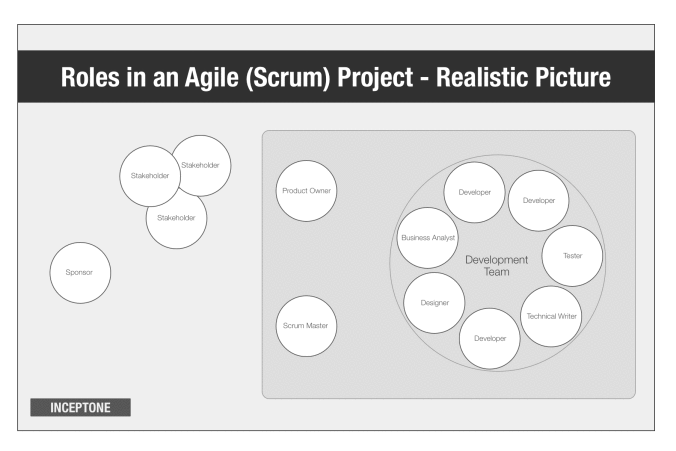Who are the people involved in an Agile (Scrum) Project?
We looked a the people involved in a standard project through their roles in Who are the People Involved in a Project?
In this post, let's look at Scrum. For Scrum, the roles have some specific names and also some specific responsibilities.
In Scrum, we're down to three roles - Product Owner, Scrum Master and the Team (or Development Team). Let's look at at each of these.
Product Owner: In case of a standard project, you had your key stakeholder (sometimes also called "Business" guy/gal). The easiest way to define the Product Owner (if you're transitioning from a standard project) is a morphing of the Key Stakeholder. This person knows the Product and the Business well and is in a position to decide what features are needed to be developed, and when, and in which priority. This person is the bridge that connects the team to the Business.
Scrum Team
Scrum Master: This person is nobody or everybody, depending upon how you look at him/her. Scrum Master is the glue that ties all of these people together and also the oil that makes sure the Scrum machine functions without heating up or breaking down.
Development Team: These are again the people who are responsible to deliver the features required by the business, and at the requested level of quality. There are many people included in the team - ideally sized between 7 +/- 2. Now the best-case scenario is that every member is completely cross-functional and is able to pick any of the tasks available in the backlog. More realistically, you'll find people having specific skillets, to which that have added certain level of cross-functionality. Think about a soccer team - every player can play soccer at every position if required, but is a specialist only for specific positions. This brings both flexibility and clarity and performance. Below are the skill-set based roles you might typically find people having within the Scrum development team. Mind you that these are not defined by the Scrum literature, but something you'll see in practice. In addition to the specific responsibilities they take on, they also bear Scrum-related responsibilities (which is outside the scope of this post).
Designers: These are the people who are responsible to bring to sight, the idea of the business. Its the first step of "if you can see it, you can get it". This makes the vision of the next business idea tangible - through Screen Designs, Graphic Designs and a lot of fancy things :).
Developers: These are the people who give life to the feature/product in the form of function. They work with the Designers and the Product Owner to understand how the feature/product should look and function. Depending on the project this could vary in range in the scale of collaboration.
Testers: These are the people who ensure the feature/product is developed at the quality requested, that everything functions as expected. Again, depending on the project this could vary in range in the scale of collaboration.
Business Analysts: Responsible to bring clarity to the business requirements and validate features developed from a Business point of view. Business Analysts are however not as common as Designers, Developers and Testers.
Technical Writers: Responsible for documenting the developed features in case user-documentation is a business requirement for most developed-features and documentation process is being managed through Scrum. Technical Writers as well are not as common as Designers, Developers and Testers.
In a Scrum-based project, you'll also encounter Stakeholder(s) and Sponsor(s), whose roles are not defined within the Scrum literature, but generally would exist within an organization following Management or Project Management practices. Their roles are pretty similar to those in a standard project, so, I'm not going to explain those roles again here.

